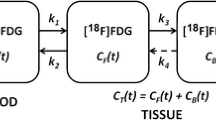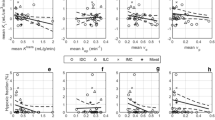Abstract
The objective of this study was to investigate the relationship between vascular and metabolic characteristics of breast tumours in vivo, using contrast-enhanced dynamic MRI and 2-[18F] fluoro-2-deoxy-d-glucose (FDG) PET imaging. Twenty patients with large or locally advanced primary breast cancers were imaged prior to therapy. MRI data were acquired using a dynamic gradient echo sequence and analysed using two pharmacokinetic models. Static PET data were acquired in 2D mode. A significant association (P<0.05) was observed between the calculated exchange rate constants of both pharmacokinetic models and calculated PET FDG dose uptake ratios (DUR). Statistical analysis showed that the exchange rate constants can explain between 27 and 44% of the variance observed in the PET FDG uptake ratios. A relationship was demonstrated between the vascular and metabolic characteristics of primary breast tumours showing that any assessment of tumour metabolic activity using PET may be controlled at least in part by delivery of uptake agent due to the vascular characteristics of the tumour. MRI and PET provide methods of assessing breast tumour vascularity and metabolism in vivo using the exchange rate constants of dynamic MRI, and DUR of PET, respectively, these measures being related but not equivalent.





Similar content being viewed by others
References
Semple SIK, Gilbert FJ, Redpath TW, Ahearn TS, Welch AE, Hutcheon AW, Heys SD, Smyth EH, Miller ID, Smith IC (2003) Correlation of MRI-PET rim enhancement in breast cancer. A delivery related phenomenon with therapy implications? Lancet Oncol 4:759
Heywang SH (1994) Contrast enhanced magnetic resonance imaging of the breast. Invest Radiol 29:94–104
Flickinger FW, Allison JD, Sherry RM, Wright JC (1993) Differentiation of benign from malignant breast masses by time-intensity evaluation of contrast-enhanced MRI. J Magn Reson Imaging 11:617–620
Tsuboi N, Inomata T, Ogawa Y, Yoshida D, Yoshida S, Moriki T, Kumon M (1999) Changes in the findings of dynamic MRI by preoperative CAF chemotherapy for patients with breast cancer of stage II and III: pathologic correlation. Oncol Rep 6:727–732
Kuhl CK (2000) MRI of breast tumors. Eur Radiol 10:46–58
Hayes C, Padhani AR, Leach MO (2002) Assessing changes in tumour vascular function using dynamic contrast-enhanced magnetic resonance imaging. NMR Biomed 15:154–163
Rieber A, Brambs H-J, Gabelmann A, Heilmann V, Keinberg R, Kühn T (2002) Breast MRI for monitoring response of primary breast cancer to neo-adjuvant chemotherapy. Eur Radiol 12:1711–1719
Tofts PS, Berkowitz B, Schnall MD (1995) Quantitative analysis of dynamic Gd-DTPA enhancement in breast tumours using a permeability model. J Magn Reson Med 33:564–568
Hoffman U, Brix G, Knopp MV, Heß T, Lorenz WJ (1995) Pharmacokinetic mapping of the breast: a new method for dynamic mammography. J Magn Reson Med 33:506–514
Bombardieri E, Crippa F, Maffioli L, Greco M (1997) Nuclear medicine techniques for the study of breast cancer. Eur J Nucl Med 24:809–824
Flanagan FL, Dehdashti F, Siegel BA (1998) PET in breast cancer. Semin Nucl Med 28:290–302
Wahl RL, Zasadny K, Helvie M, Hutchins GD, Weber B, Cody R (1993) Metabolic monitoring of breast cancer chemohormonotherapy using positron emission tomography: initial evaluation. J Clin Oncol 11:2101–2111
Bassa P, Kim EE, Inoue T, Wong FCL, Korkmaz M, Yang DJ, Wong WH, Hicks KW, Buzdar AU, Podoloff DA (1996) Evaluation of preoperative chemotherapy using PET with fluorine-18-flourodeoxyglucose in breast cancer. J Nucl Med 37:931–938
Smith IC, Welch AE, Hutcheon AW, Miller ID, Payne S, Chilcott F, Waikar S, Whitaker T, Ah-See AK, Eremin O, Heys SD, Gilbert FJ, Sharp PF (2000) Positron emission tomography using [18F]-fluorodeoxy-d-glucose to predict the pathologic response of breast cancer to primary chemotherapy. J Clin Oncol 18:1676–1688
Brix G, Henze M, Knopp MV, Lucht R, Doll J, Junkermann H, Hawighorst H, Haberkorn U (2001) Comparison of pharmacokinetic MRI and [18F] fluorodeoxyglucose PET in the diagnosis of breast cancer: initial experience. Eur Radiol 11:2058–2070
Wienhard K, Eriksson K, Grootoonk S, Casey M, Pietrzyk U, Heiss WD (1992) Performance evaluation of the positron scanner ECAT EXACT. J Comput Assist Tomogr 16:804–813
Semple SIK, Redpath TW, Ahearn TS, Gilbert FJ, Hutcheon AW, Heys SD (2003) Effect of accurate T1 calculation on pharmacokinetic analysis of primary breast cancer. In: Proceedings of the 11th annual meeting of ISMRM, Toronto, Canada
Tofts PS, Kermode AG (1991) Measurement of the blood–brain barrier permeability and leakage space using dynamic MR imaging. 1. Fundamental concepts. J Magn Res Med 17:357–367
Brix G, Semmler W, Port R, Schad LR, Layer G, Lorenz WJ (1991) Pharmacokinetic parameters in CNS Gd-DTPA enhanced MR imaging. J Comput Assist Tomogr 15:621–628
Knopp MV, Brix G, Junkermann HJ, Sinn HP (1994) MR mammography with pharmacokinetic mapping for monitoring of breast cancer treatment during neoadjuvant therapy. Magn Reson Imaging Clin N Am 2:633–658
Tofts PS, Brix G, Buckley DL, Eveloch JL, Henderson E, Knopp M, Larsson HBW, Lee T-Y, Mayr NA, Parker GJM, Port RE, Taylor J, Weisskoff RM (1999) Estimating kinetic parameters from dynamic contrast-enhanced T1-weighted MRI of a diffusable tracer: standardized quantities and symbols. J Magn Reson Imaging 10:223–232
Ahearn TS (2003) The accuracy and robustness of dynamic contrast enhanced magnetic resonance imaging methodology. Ph.D Thesis, University of Aberdeen, pp 159–174
Hathaway PB, Mankoff DA, Maravilla KR, Austin-Seymour MM, Ellis GK, Gralow JR, Cortese AA, Hayes CE, Moe RE (1999) Value of combined FDG PET and MR imaging in the evaluation of suspected recurrent local-regional breast cancer: preliminary experience. Radiology 210:807–814
Goerres GW, Michel SCA, Fehr MK, Kaim AH, Steinert HC, Seifert B, von Schulthess GK, Kubik-Huch RA (2003) Follow-up of women with breast cancer: comparison between MRI and FDG PET. Eur Radiol 13:1635–1644
Kim CK, Gupta NC, Chanramouli B, Alavi A (1994) Standardized uptake values of FDG: body surface area correction is preferable to body weight correction. J Nucl Med 35:164–167
Weinmann HJ, Laniado M, Mutzel W (1984) Pharmacokinetics of Gd-DTPA/Dimeglumine after intravenous injection into healthy volunteers. Physiol Chem Phys Med NMR 16:167–172
Williams KV, Bertoldo A, Mattioni B, Price JC, Cobelli C, Kelley DE (2003) Glucose transport and phosphorylation in skeletal muscle in obesity: insight into a muscle-specific positron emission tomography model. J Clin Endocrinol Metab 88:1271–1279
Zasadny KR, Tatsumi M, Wahl RL (2003) FDG metabolism and uptake versus blood flow in women with untreated primary breast cancers. Eur J Nucl Med Mol Imaging 30:274–280
Mankoff DA, Dunnwald LK, Gralow JR, Ellis GK, Charlop A, Lawton TJ, Schubert EK, Tseng J, Livingston RB (2002) Blood flow and metabolism in locally advanced breast cancer: relationship to response to therapy. J Nucl Med 43:500–509
Mankoff DA, Dunnwald LK, Gralow JR, Ellis GK, Schubert EK, Tseng J, Lawton TJ, Linden HM, Livingston RB (2003) Changes in blood flow and metabolism in locally advanced breast cancer treated with neoadjuvant chemotherapy. J Nucl Med 44:1806–1814
Author information
Authors and Affiliations
Corresponding author
Rights and permissions
About this article
Cite this article
Semple, S.I.K., Gilbert, F.J., Redpath, T.W. et al. The relationship between vascular and metabolic characteristics of primary breast tumours. Eur Radiol 14, 2038–2045 (2004). https://doi.org/10.1007/s00330-004-2454-6
Received:
Revised:
Accepted:
Published:
Issue Date:
DOI: https://doi.org/10.1007/s00330-004-2454-6




